Environmental Science Report: Earth's Oceans and Composition
VerifiedAdded on 2020/07/23
|10
|3685
|41
Report
AI Summary
This report delves into the multifaceted realm of environmental science, focusing on the geological and historical emergence of oceans. It meticulously explores the Earth's components, processes contributing to ocean formation, and the rise of landmasses. The report further examines continental drift, plate formation, and boundaries, while also identifying micronutrients, abyss plains, and seamounts. The influence of the Earth's magnetic field on ocean features is analyzed, alongside a detailed description of ocean composition and the physical properties of seawater, sand, and rock formations. Moreover, it addresses the effects of climate on sea levels and evaluates conservation strategies, concluding with a critical assessment of data related to marine biology control strategies. The report provides a comprehensive understanding of the interconnected elements shaping our oceans and their environment.
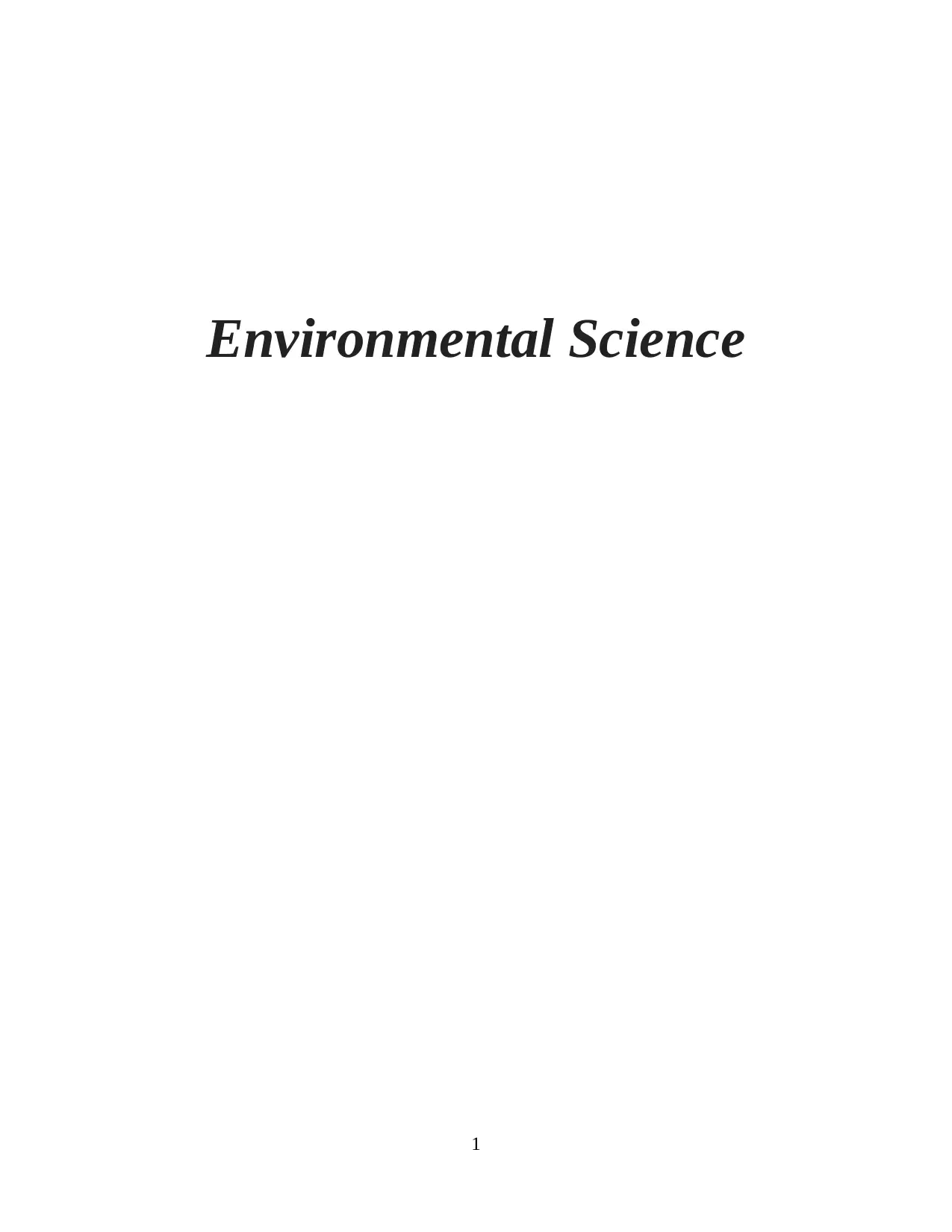
Environmental Science
1
1
Paraphrase This Document
Need a fresh take? Get an instant paraphrase of this document with our AI Paraphraser
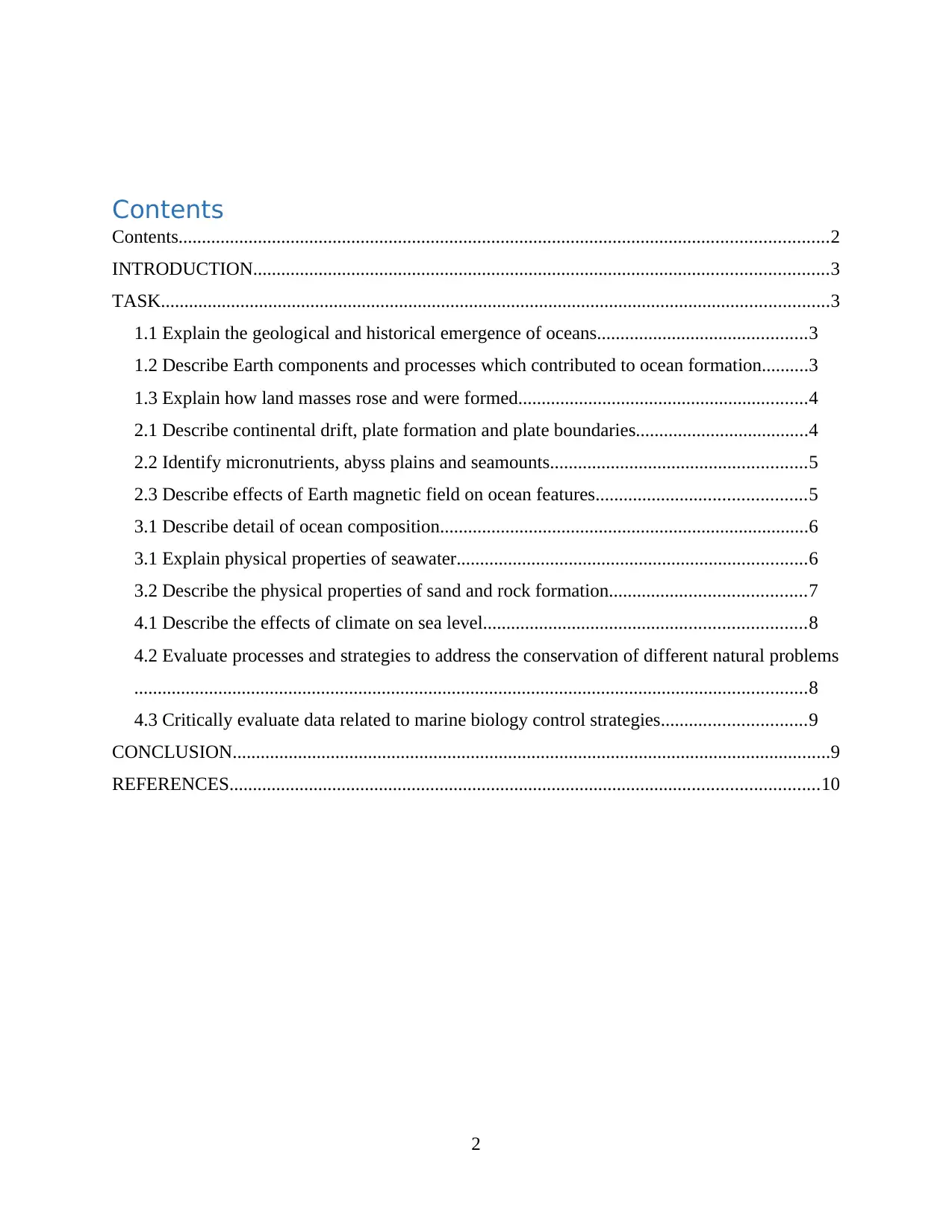
Contents
Contents...........................................................................................................................................2
INTRODUCTION...........................................................................................................................3
TASK...............................................................................................................................................3
1.1 Explain the geological and historical emergence of oceans.............................................3
1.2 Describe Earth components and processes which contributed to ocean formation..........3
1.3 Explain how land masses rose and were formed..............................................................4
2.1 Describe continental drift, plate formation and plate boundaries.....................................4
2.2 Identify micronutrients, abyss plains and seamounts.......................................................5
2.3 Describe effects of Earth magnetic field on ocean features.............................................5
3.1 Describe detail of ocean composition...............................................................................6
3.1 Explain physical properties of seawater...........................................................................6
3.2 Describe the physical properties of sand and rock formation..........................................7
4.1 Describe the effects of climate on sea level.....................................................................8
4.2 Evaluate processes and strategies to address the conservation of different natural problems
................................................................................................................................................8
4.3 Critically evaluate data related to marine biology control strategies...............................9
CONCLUSION................................................................................................................................9
REFERENCES..............................................................................................................................10
2
Contents...........................................................................................................................................2
INTRODUCTION...........................................................................................................................3
TASK...............................................................................................................................................3
1.1 Explain the geological and historical emergence of oceans.............................................3
1.2 Describe Earth components and processes which contributed to ocean formation..........3
1.3 Explain how land masses rose and were formed..............................................................4
2.1 Describe continental drift, plate formation and plate boundaries.....................................4
2.2 Identify micronutrients, abyss plains and seamounts.......................................................5
2.3 Describe effects of Earth magnetic field on ocean features.............................................5
3.1 Describe detail of ocean composition...............................................................................6
3.1 Explain physical properties of seawater...........................................................................6
3.2 Describe the physical properties of sand and rock formation..........................................7
4.1 Describe the effects of climate on sea level.....................................................................8
4.2 Evaluate processes and strategies to address the conservation of different natural problems
................................................................................................................................................8
4.3 Critically evaluate data related to marine biology control strategies...............................9
CONCLUSION................................................................................................................................9
REFERENCES..............................................................................................................................10
2
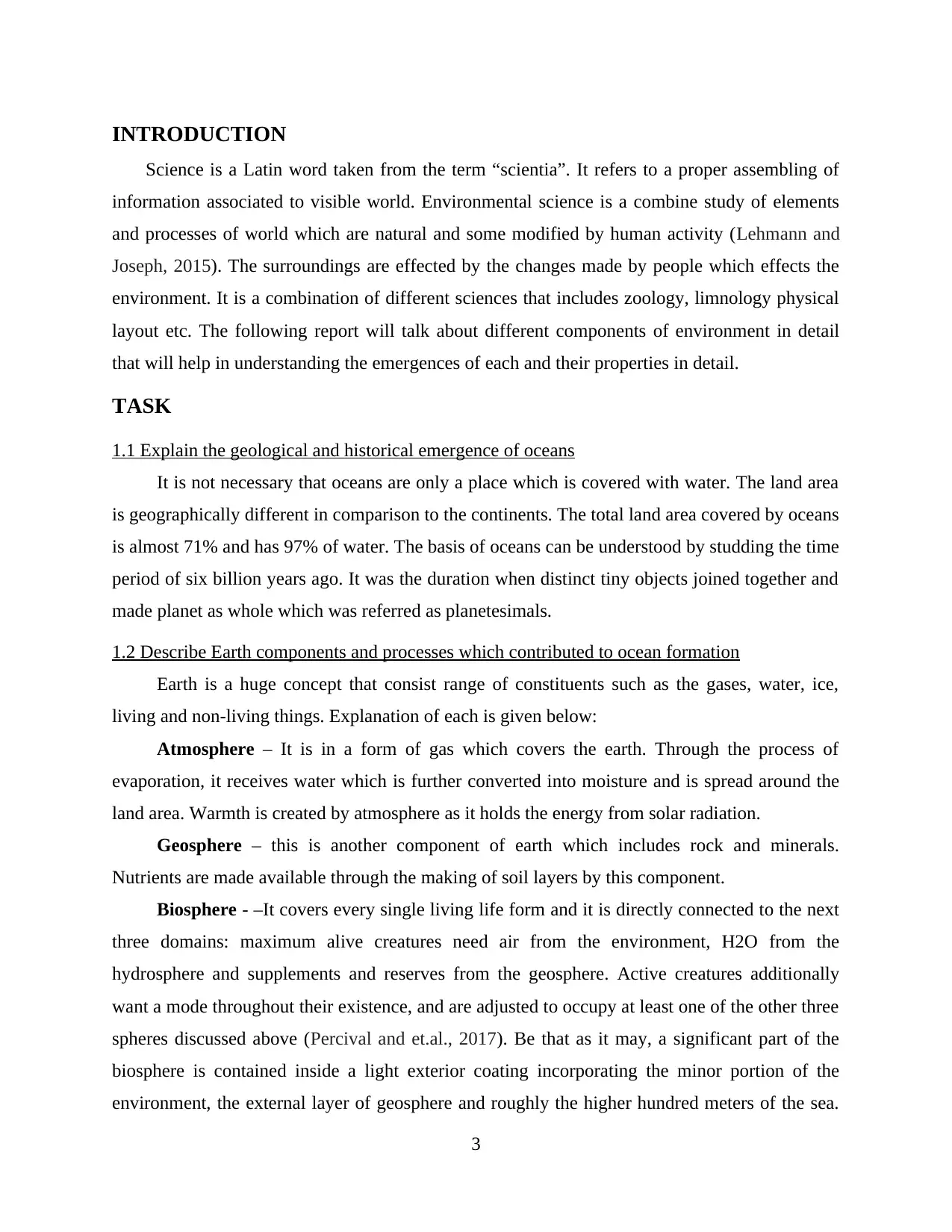
INTRODUCTION
Science is a Latin word taken from the term “scientia”. It refers to a proper assembling of
information associated to visible world. Environmental science is a combine study of elements
and processes of world which are natural and some modified by human activity (Lehmann and
Joseph, 2015). The surroundings are effected by the changes made by people which effects the
environment. It is a combination of different sciences that includes zoology, limnology physical
layout etc. The following report will talk about different components of environment in detail
that will help in understanding the emergences of each and their properties in detail.
TASK
1.1 Explain the geological and historical emergence of oceans
It is not necessary that oceans are only a place which is covered with water. The land area
is geographically different in comparison to the continents. The total land area covered by oceans
is almost 71% and has 97% of water. The basis of oceans can be understood by studding the time
period of six billion years ago. It was the duration when distinct tiny objects joined together and
made planet as whole which was referred as planetesimals.
1.2 Describe Earth components and processes which contributed to ocean formation
Earth is a huge concept that consist range of constituents such as the gases, water, ice,
living and non-living things. Explanation of each is given below:
Atmosphere – It is in a form of gas which covers the earth. Through the process of
evaporation, it receives water which is further converted into moisture and is spread around the
land area. Warmth is created by atmosphere as it holds the energy from solar radiation.
Geosphere – this is another component of earth which includes rock and minerals.
Nutrients are made available through the making of soil layers by this component.
Biosphere - –It covers every single living life form and it is directly connected to the next
three domains: maximum alive creatures need air from the environment, H2O from the
hydrosphere and supplements and reserves from the geosphere. Active creatures additionally
want a mode throughout their existence, and are adjusted to occupy at least one of the other three
spheres discussed above (Percival and et.al., 2017). Be that as it may, a significant part of the
biosphere is contained inside a light exterior coating incorporating the minor portion of the
environment, the external layer of geosphere and roughly the higher hundred meters of the sea.
3
Science is a Latin word taken from the term “scientia”. It refers to a proper assembling of
information associated to visible world. Environmental science is a combine study of elements
and processes of world which are natural and some modified by human activity (Lehmann and
Joseph, 2015). The surroundings are effected by the changes made by people which effects the
environment. It is a combination of different sciences that includes zoology, limnology physical
layout etc. The following report will talk about different components of environment in detail
that will help in understanding the emergences of each and their properties in detail.
TASK
1.1 Explain the geological and historical emergence of oceans
It is not necessary that oceans are only a place which is covered with water. The land area
is geographically different in comparison to the continents. The total land area covered by oceans
is almost 71% and has 97% of water. The basis of oceans can be understood by studding the time
period of six billion years ago. It was the duration when distinct tiny objects joined together and
made planet as whole which was referred as planetesimals.
1.2 Describe Earth components and processes which contributed to ocean formation
Earth is a huge concept that consist range of constituents such as the gases, water, ice,
living and non-living things. Explanation of each is given below:
Atmosphere – It is in a form of gas which covers the earth. Through the process of
evaporation, it receives water which is further converted into moisture and is spread around the
land area. Warmth is created by atmosphere as it holds the energy from solar radiation.
Geosphere – this is another component of earth which includes rock and minerals.
Nutrients are made available through the making of soil layers by this component.
Biosphere - –It covers every single living life form and it is directly connected to the next
three domains: maximum alive creatures need air from the environment, H2O from the
hydrosphere and supplements and reserves from the geosphere. Active creatures additionally
want a mode throughout their existence, and are adjusted to occupy at least one of the other three
spheres discussed above (Percival and et.al., 2017). Be that as it may, a significant part of the
biosphere is contained inside a light exterior coating incorporating the minor portion of the
environment, the external layer of geosphere and roughly the higher hundred meters of the sea.
3
⊘ This is a preview!⊘
Do you want full access?
Subscribe today to unlock all pages.

Trusted by 1+ million students worldwide
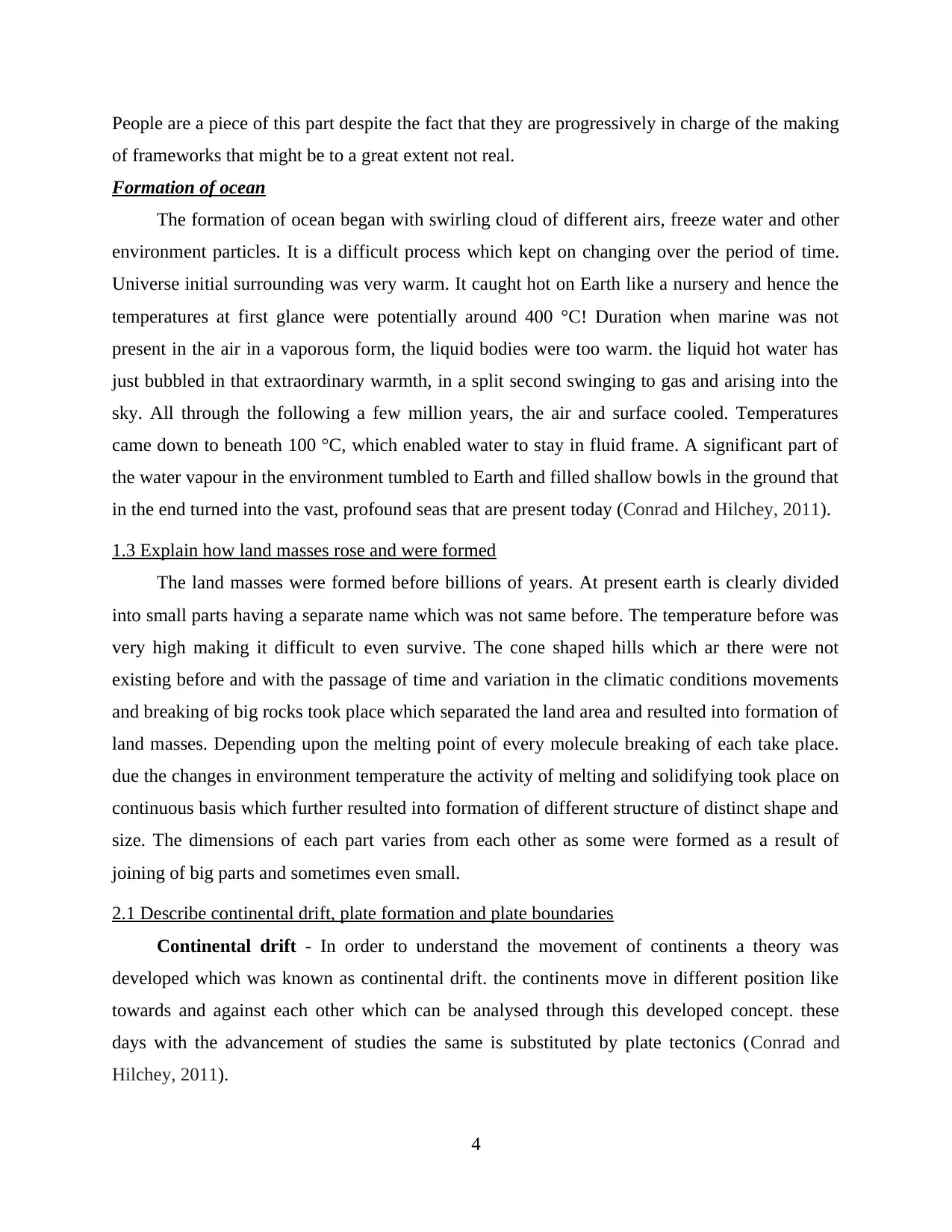
People are a piece of this part despite the fact that they are progressively in charge of the making
of frameworks that might be to a great extent not real.
Formation of ocean
The formation of ocean began with swirling cloud of different airs, freeze water and other
environment particles. It is a difficult process which kept on changing over the period of time.
Universe initial surrounding was very warm. It caught hot on Earth like a nursery and hence the
temperatures at first glance were potentially around 400 °C! Duration when marine was not
present in the air in a vaporous form, the liquid bodies were too warm. the liquid hot water has
just bubbled in that extraordinary warmth, in a split second swinging to gas and arising into the
sky. All through the following a few million years, the air and surface cooled. Temperatures
came down to beneath 100 °C, which enabled water to stay in fluid frame. A significant part of
the water vapour in the environment tumbled to Earth and filled shallow bowls in the ground that
in the end turned into the vast, profound seas that are present today (Conrad and Hilchey, 2011).
1.3 Explain how land masses rose and were formed
The land masses were formed before billions of years. At present earth is clearly divided
into small parts having a separate name which was not same before. The temperature before was
very high making it difficult to even survive. The cone shaped hills which ar there were not
existing before and with the passage of time and variation in the climatic conditions movements
and breaking of big rocks took place which separated the land area and resulted into formation of
land masses. Depending upon the melting point of every molecule breaking of each take place.
due the changes in environment temperature the activity of melting and solidifying took place on
continuous basis which further resulted into formation of different structure of distinct shape and
size. The dimensions of each part varies from each other as some were formed as a result of
joining of big parts and sometimes even small.
2.1 Describe continental drift, plate formation and plate boundaries
Continental drift - In order to understand the movement of continents a theory was
developed which was known as continental drift. the continents move in different position like
towards and against each other which can be analysed through this developed concept. these
days with the advancement of studies the same is substituted by plate tectonics (Conrad and
Hilchey, 2011).
4
of frameworks that might be to a great extent not real.
Formation of ocean
The formation of ocean began with swirling cloud of different airs, freeze water and other
environment particles. It is a difficult process which kept on changing over the period of time.
Universe initial surrounding was very warm. It caught hot on Earth like a nursery and hence the
temperatures at first glance were potentially around 400 °C! Duration when marine was not
present in the air in a vaporous form, the liquid bodies were too warm. the liquid hot water has
just bubbled in that extraordinary warmth, in a split second swinging to gas and arising into the
sky. All through the following a few million years, the air and surface cooled. Temperatures
came down to beneath 100 °C, which enabled water to stay in fluid frame. A significant part of
the water vapour in the environment tumbled to Earth and filled shallow bowls in the ground that
in the end turned into the vast, profound seas that are present today (Conrad and Hilchey, 2011).
1.3 Explain how land masses rose and were formed
The land masses were formed before billions of years. At present earth is clearly divided
into small parts having a separate name which was not same before. The temperature before was
very high making it difficult to even survive. The cone shaped hills which ar there were not
existing before and with the passage of time and variation in the climatic conditions movements
and breaking of big rocks took place which separated the land area and resulted into formation of
land masses. Depending upon the melting point of every molecule breaking of each take place.
due the changes in environment temperature the activity of melting and solidifying took place on
continuous basis which further resulted into formation of different structure of distinct shape and
size. The dimensions of each part varies from each other as some were formed as a result of
joining of big parts and sometimes even small.
2.1 Describe continental drift, plate formation and plate boundaries
Continental drift - In order to understand the movement of continents a theory was
developed which was known as continental drift. the continents move in different position like
towards and against each other which can be analysed through this developed concept. these
days with the advancement of studies the same is substituted by plate tectonics (Conrad and
Hilchey, 2011).
4
Paraphrase This Document
Need a fresh take? Get an instant paraphrase of this document with our AI Paraphraser
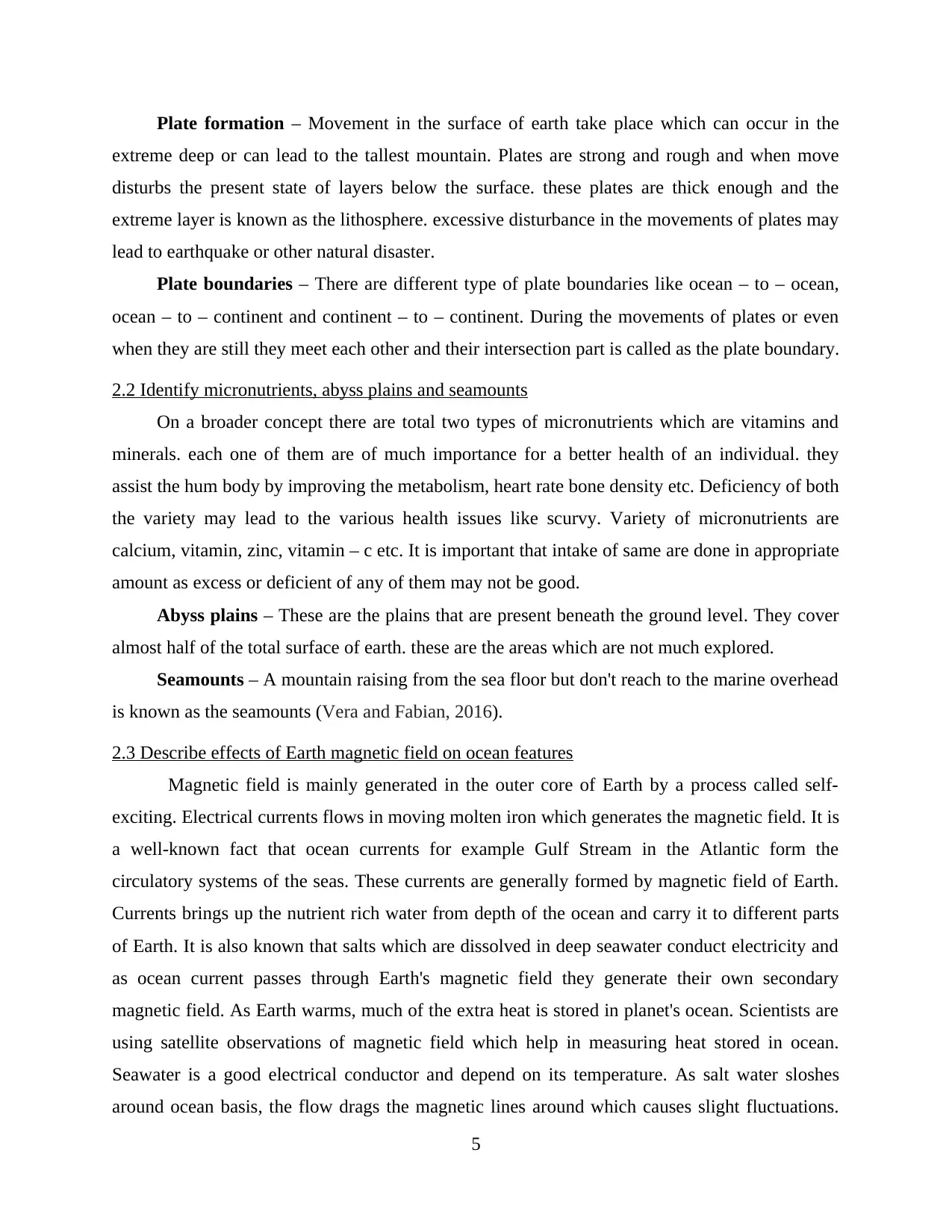
Plate formation – Movement in the surface of earth take place which can occur in the
extreme deep or can lead to the tallest mountain. Plates are strong and rough and when move
disturbs the present state of layers below the surface. these plates are thick enough and the
extreme layer is known as the lithosphere. excessive disturbance in the movements of plates may
lead to earthquake or other natural disaster.
Plate boundaries – There are different type of plate boundaries like ocean – to – ocean,
ocean – to – continent and continent – to – continent. During the movements of plates or even
when they are still they meet each other and their intersection part is called as the plate boundary.
2.2 Identify micronutrients, abyss plains and seamounts
On a broader concept there are total two types of micronutrients which are vitamins and
minerals. each one of them are of much importance for a better health of an individual. they
assist the hum body by improving the metabolism, heart rate bone density etc. Deficiency of both
the variety may lead to the various health issues like scurvy. Variety of micronutrients are
calcium, vitamin, zinc, vitamin – c etc. It is important that intake of same are done in appropriate
amount as excess or deficient of any of them may not be good.
Abyss plains – These are the plains that are present beneath the ground level. They cover
almost half of the total surface of earth. these are the areas which are not much explored.
Seamounts – A mountain raising from the sea floor but don't reach to the marine overhead
is known as the seamounts (Vera and Fabian, 2016).
2.3 Describe effects of Earth magnetic field on ocean features
Magnetic field is mainly generated in the outer core of Earth by a process called self-
exciting. Electrical currents flows in moving molten iron which generates the magnetic field. It is
a well-known fact that ocean currents for example Gulf Stream in the Atlantic form the
circulatory systems of the seas. These currents are generally formed by magnetic field of Earth.
Currents brings up the nutrient rich water from depth of the ocean and carry it to different parts
of Earth. It is also known that salts which are dissolved in deep seawater conduct electricity and
as ocean current passes through Earth's magnetic field they generate their own secondary
magnetic field. As Earth warms, much of the extra heat is stored in planet's ocean. Scientists are
using satellite observations of magnetic field which help in measuring heat stored in ocean.
Seawater is a good electrical conductor and depend on its temperature. As salt water sloshes
around ocean basis, the flow drags the magnetic lines around which causes slight fluctuations.
5
extreme deep or can lead to the tallest mountain. Plates are strong and rough and when move
disturbs the present state of layers below the surface. these plates are thick enough and the
extreme layer is known as the lithosphere. excessive disturbance in the movements of plates may
lead to earthquake or other natural disaster.
Plate boundaries – There are different type of plate boundaries like ocean – to – ocean,
ocean – to – continent and continent – to – continent. During the movements of plates or even
when they are still they meet each other and their intersection part is called as the plate boundary.
2.2 Identify micronutrients, abyss plains and seamounts
On a broader concept there are total two types of micronutrients which are vitamins and
minerals. each one of them are of much importance for a better health of an individual. they
assist the hum body by improving the metabolism, heart rate bone density etc. Deficiency of both
the variety may lead to the various health issues like scurvy. Variety of micronutrients are
calcium, vitamin, zinc, vitamin – c etc. It is important that intake of same are done in appropriate
amount as excess or deficient of any of them may not be good.
Abyss plains – These are the plains that are present beneath the ground level. They cover
almost half of the total surface of earth. these are the areas which are not much explored.
Seamounts – A mountain raising from the sea floor but don't reach to the marine overhead
is known as the seamounts (Vera and Fabian, 2016).
2.3 Describe effects of Earth magnetic field on ocean features
Magnetic field is mainly generated in the outer core of Earth by a process called self-
exciting. Electrical currents flows in moving molten iron which generates the magnetic field. It is
a well-known fact that ocean currents for example Gulf Stream in the Atlantic form the
circulatory systems of the seas. These currents are generally formed by magnetic field of Earth.
Currents brings up the nutrient rich water from depth of the ocean and carry it to different parts
of Earth. It is also known that salts which are dissolved in deep seawater conduct electricity and
as ocean current passes through Earth's magnetic field they generate their own secondary
magnetic field. As Earth warms, much of the extra heat is stored in planet's ocean. Scientists are
using satellite observations of magnetic field which help in measuring heat stored in ocean.
Seawater is a good electrical conductor and depend on its temperature. As salt water sloshes
around ocean basis, the flow drags the magnetic lines around which causes slight fluctuations.
5
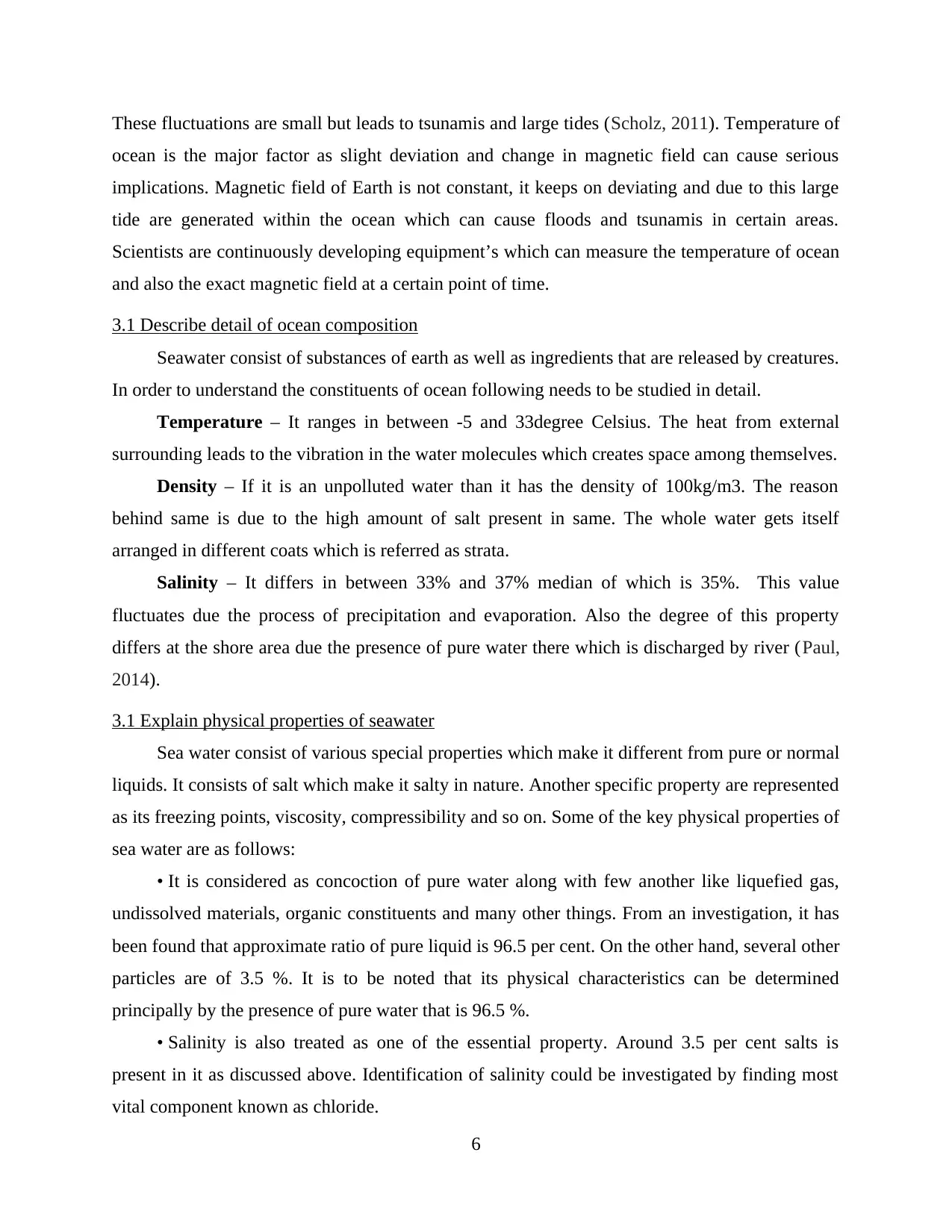
These fluctuations are small but leads to tsunamis and large tides (Scholz, 2011). Temperature of
ocean is the major factor as slight deviation and change in magnetic field can cause serious
implications. Magnetic field of Earth is not constant, it keeps on deviating and due to this large
tide are generated within the ocean which can cause floods and tsunamis in certain areas.
Scientists are continuously developing equipment’s which can measure the temperature of ocean
and also the exact magnetic field at a certain point of time.
3.1 Describe detail of ocean composition
Seawater consist of substances of earth as well as ingredients that are released by creatures.
In order to understand the constituents of ocean following needs to be studied in detail.
Temperature – It ranges in between -5 and 33degree Celsius. The heat from external
surrounding leads to the vibration in the water molecules which creates space among themselves.
Density – If it is an unpolluted water than it has the density of 100kg/m3. The reason
behind same is due to the high amount of salt present in same. The whole water gets itself
arranged in different coats which is referred as strata.
Salinity – It differs in between 33% and 37% median of which is 35%. This value
fluctuates due the process of precipitation and evaporation. Also the degree of this property
differs at the shore area due the presence of pure water there which is discharged by river (Paul,
2014).
3.1 Explain physical properties of seawater
Sea water consist of various special properties which make it different from pure or normal
liquids. It consists of salt which make it salty in nature. Another specific property are represented
as its freezing points, viscosity, compressibility and so on. Some of the key physical properties of
sea water are as follows:
• It is considered as concoction of pure water along with few another like liquefied gas,
undissolved materials, organic constituents and many other things. From an investigation, it has
been found that approximate ratio of pure liquid is 96.5 per cent. On the other hand, several other
particles are of 3.5 %. It is to be noted that its physical characteristics can be determined
principally by the presence of pure water that is 96.5 %.
• Salinity is also treated as one of the essential property. Around 3.5 per cent salts is
present in it as discussed above. Identification of salinity could be investigated by finding most
vital component known as chloride.
6
ocean is the major factor as slight deviation and change in magnetic field can cause serious
implications. Magnetic field of Earth is not constant, it keeps on deviating and due to this large
tide are generated within the ocean which can cause floods and tsunamis in certain areas.
Scientists are continuously developing equipment’s which can measure the temperature of ocean
and also the exact magnetic field at a certain point of time.
3.1 Describe detail of ocean composition
Seawater consist of substances of earth as well as ingredients that are released by creatures.
In order to understand the constituents of ocean following needs to be studied in detail.
Temperature – It ranges in between -5 and 33degree Celsius. The heat from external
surrounding leads to the vibration in the water molecules which creates space among themselves.
Density – If it is an unpolluted water than it has the density of 100kg/m3. The reason
behind same is due to the high amount of salt present in same. The whole water gets itself
arranged in different coats which is referred as strata.
Salinity – It differs in between 33% and 37% median of which is 35%. This value
fluctuates due the process of precipitation and evaporation. Also the degree of this property
differs at the shore area due the presence of pure water there which is discharged by river (Paul,
2014).
3.1 Explain physical properties of seawater
Sea water consist of various special properties which make it different from pure or normal
liquids. It consists of salt which make it salty in nature. Another specific property are represented
as its freezing points, viscosity, compressibility and so on. Some of the key physical properties of
sea water are as follows:
• It is considered as concoction of pure water along with few another like liquefied gas,
undissolved materials, organic constituents and many other things. From an investigation, it has
been found that approximate ratio of pure liquid is 96.5 per cent. On the other hand, several other
particles are of 3.5 %. It is to be noted that its physical characteristics can be determined
principally by the presence of pure water that is 96.5 %.
• Salinity is also treated as one of the essential property. Around 3.5 per cent salts is
present in it as discussed above. Identification of salinity could be investigated by finding most
vital component known as chloride.
6
⊘ This is a preview!⊘
Do you want full access?
Subscribe today to unlock all pages.

Trusted by 1+ million students worldwide
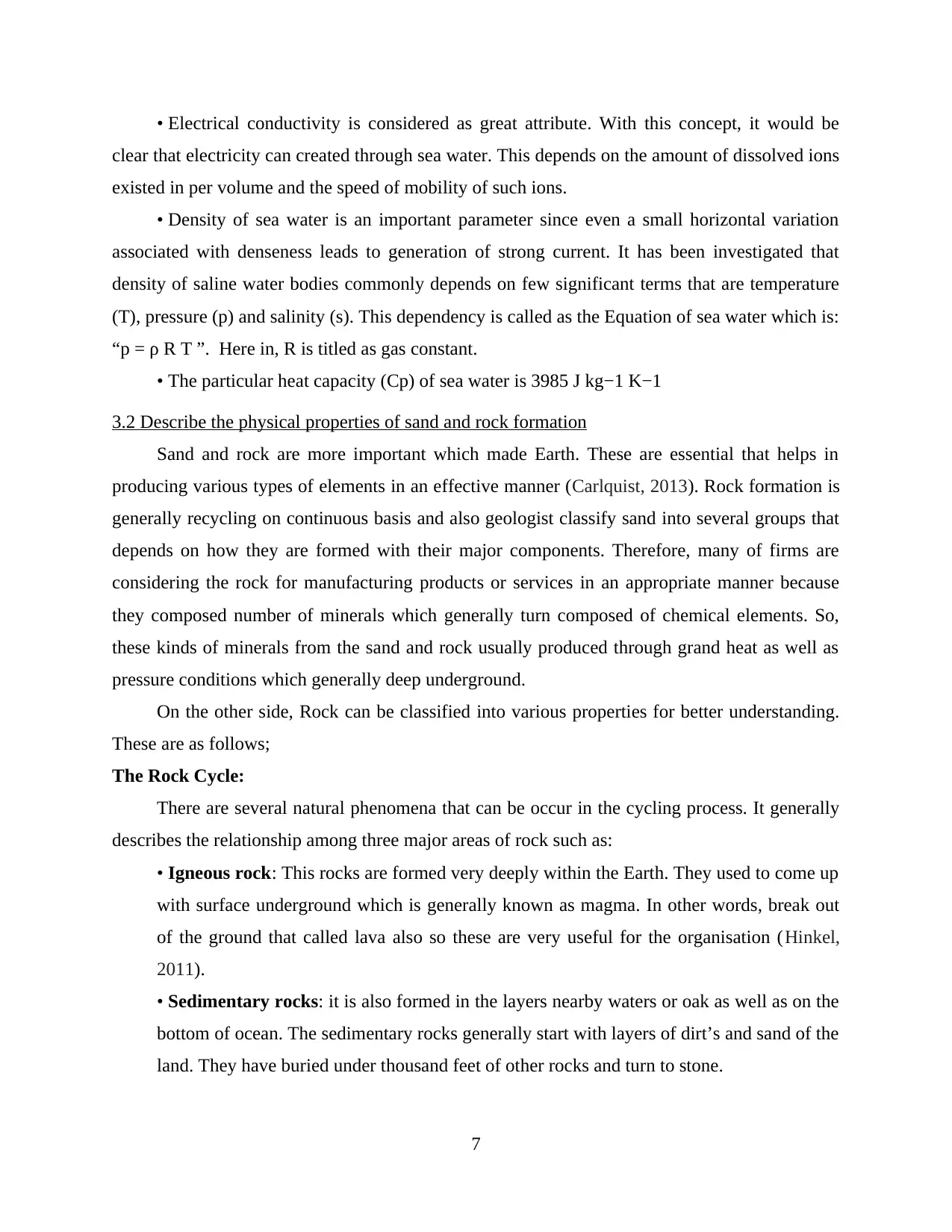
• Electrical conductivity is considered as great attribute. With this concept, it would be
clear that electricity can created through sea water. This depends on the amount of dissolved ions
existed in per volume and the speed of mobility of such ions.
• Density of sea water is an important parameter since even a small horizontal variation
associated with denseness leads to generation of strong current. It has been investigated that
density of saline water bodies commonly depends on few significant terms that are temperature
(T), pressure (p) and salinity (s). This dependency is called as the Equation of sea water which is:
“p = ρ R T ”. Here in, R is titled as gas constant.
• The particular heat capacity (Cp) of sea water is 3985 J kg−1 K−1
3.2 Describe the physical properties of sand and rock formation
Sand and rock are more important which made Earth. These are essential that helps in
producing various types of elements in an effective manner (Carlquist, 2013). Rock formation is
generally recycling on continuous basis and also geologist classify sand into several groups that
depends on how they are formed with their major components. Therefore, many of firms are
considering the rock for manufacturing products or services in an appropriate manner because
they composed number of minerals which generally turn composed of chemical elements. So,
these kinds of minerals from the sand and rock usually produced through grand heat as well as
pressure conditions which generally deep underground.
On the other side, Rock can be classified into various properties for better understanding.
These are as follows;
The Rock Cycle:
There are several natural phenomena that can be occur in the cycling process. It generally
describes the relationship among three major areas of rock such as:
• Igneous rock: This rocks are formed very deeply within the Earth. They used to come up
with surface underground which is generally known as magma. In other words, break out
of the ground that called lava also so these are very useful for the organisation (Hinkel,
2011).
• Sedimentary rocks: it is also formed in the layers nearby waters or oak as well as on the
bottom of ocean. The sedimentary rocks generally start with layers of dirt’s and sand of the
land. They have buried under thousand feet of other rocks and turn to stone.
7
clear that electricity can created through sea water. This depends on the amount of dissolved ions
existed in per volume and the speed of mobility of such ions.
• Density of sea water is an important parameter since even a small horizontal variation
associated with denseness leads to generation of strong current. It has been investigated that
density of saline water bodies commonly depends on few significant terms that are temperature
(T), pressure (p) and salinity (s). This dependency is called as the Equation of sea water which is:
“p = ρ R T ”. Here in, R is titled as gas constant.
• The particular heat capacity (Cp) of sea water is 3985 J kg−1 K−1
3.2 Describe the physical properties of sand and rock formation
Sand and rock are more important which made Earth. These are essential that helps in
producing various types of elements in an effective manner (Carlquist, 2013). Rock formation is
generally recycling on continuous basis and also geologist classify sand into several groups that
depends on how they are formed with their major components. Therefore, many of firms are
considering the rock for manufacturing products or services in an appropriate manner because
they composed number of minerals which generally turn composed of chemical elements. So,
these kinds of minerals from the sand and rock usually produced through grand heat as well as
pressure conditions which generally deep underground.
On the other side, Rock can be classified into various properties for better understanding.
These are as follows;
The Rock Cycle:
There are several natural phenomena that can be occur in the cycling process. It generally
describes the relationship among three major areas of rock such as:
• Igneous rock: This rocks are formed very deeply within the Earth. They used to come up
with surface underground which is generally known as magma. In other words, break out
of the ground that called lava also so these are very useful for the organisation (Hinkel,
2011).
• Sedimentary rocks: it is also formed in the layers nearby waters or oak as well as on the
bottom of ocean. The sedimentary rocks generally start with layers of dirt’s and sand of the
land. They have buried under thousand feet of other rocks and turn to stone.
7
Paraphrase This Document
Need a fresh take? Get an instant paraphrase of this document with our AI Paraphraser
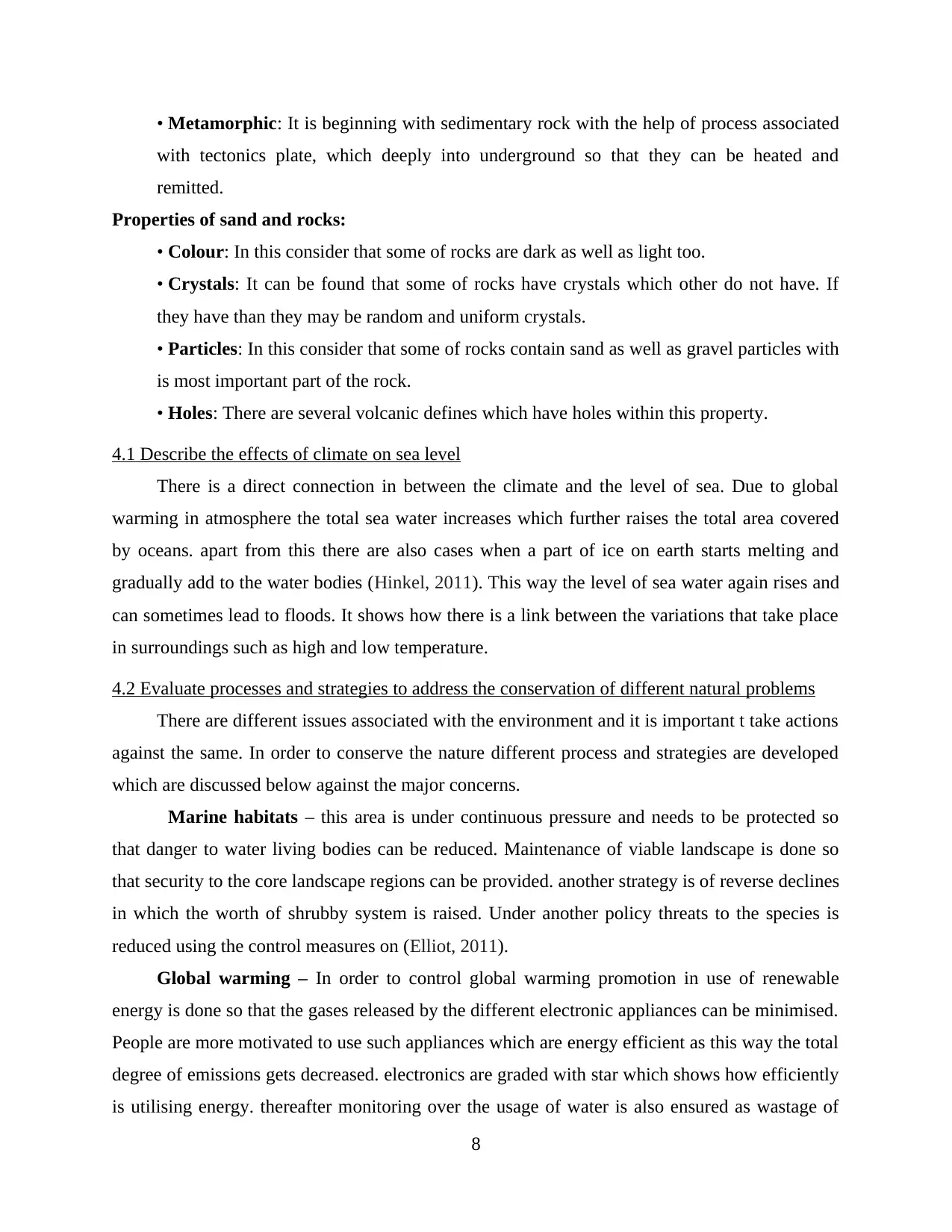
• Metamorphic: It is beginning with sedimentary rock with the help of process associated
with tectonics plate, which deeply into underground so that they can be heated and
remitted.
Properties of sand and rocks:
• Colour: In this consider that some of rocks are dark as well as light too.
• Crystals: It can be found that some of rocks have crystals which other do not have. If
they have than they may be random and uniform crystals.
• Particles: In this consider that some of rocks contain sand as well as gravel particles with
is most important part of the rock.
• Holes: There are several volcanic defines which have holes within this property.
4.1 Describe the effects of climate on sea level
There is a direct connection in between the climate and the level of sea. Due to global
warming in atmosphere the total sea water increases which further raises the total area covered
by oceans. apart from this there are also cases when a part of ice on earth starts melting and
gradually add to the water bodies (Hinkel, 2011). This way the level of sea water again rises and
can sometimes lead to floods. It shows how there is a link between the variations that take place
in surroundings such as high and low temperature.
4.2 Evaluate processes and strategies to address the conservation of different natural problems
There are different issues associated with the environment and it is important t take actions
against the same. In order to conserve the nature different process and strategies are developed
which are discussed below against the major concerns.
Marine habitats – this area is under continuous pressure and needs to be protected so
that danger to water living bodies can be reduced. Maintenance of viable landscape is done so
that security to the core landscape regions can be provided. another strategy is of reverse declines
in which the worth of shrubby system is raised. Under another policy threats to the species is
reduced using the control measures on (Elliot, 2011).
Global warming – In order to control global warming promotion in use of renewable
energy is done so that the gases released by the different electronic appliances can be minimised.
People are more motivated to use such appliances which are energy efficient as this way the total
degree of emissions gets decreased. electronics are graded with star which shows how efficiently
is utilising energy. thereafter monitoring over the usage of water is also ensured as wastage of
8
with tectonics plate, which deeply into underground so that they can be heated and
remitted.
Properties of sand and rocks:
• Colour: In this consider that some of rocks are dark as well as light too.
• Crystals: It can be found that some of rocks have crystals which other do not have. If
they have than they may be random and uniform crystals.
• Particles: In this consider that some of rocks contain sand as well as gravel particles with
is most important part of the rock.
• Holes: There are several volcanic defines which have holes within this property.
4.1 Describe the effects of climate on sea level
There is a direct connection in between the climate and the level of sea. Due to global
warming in atmosphere the total sea water increases which further raises the total area covered
by oceans. apart from this there are also cases when a part of ice on earth starts melting and
gradually add to the water bodies (Hinkel, 2011). This way the level of sea water again rises and
can sometimes lead to floods. It shows how there is a link between the variations that take place
in surroundings such as high and low temperature.
4.2 Evaluate processes and strategies to address the conservation of different natural problems
There are different issues associated with the environment and it is important t take actions
against the same. In order to conserve the nature different process and strategies are developed
which are discussed below against the major concerns.
Marine habitats – this area is under continuous pressure and needs to be protected so
that danger to water living bodies can be reduced. Maintenance of viable landscape is done so
that security to the core landscape regions can be provided. another strategy is of reverse declines
in which the worth of shrubby system is raised. Under another policy threats to the species is
reduced using the control measures on (Elliot, 2011).
Global warming – In order to control global warming promotion in use of renewable
energy is done so that the gases released by the different electronic appliances can be minimised.
People are more motivated to use such appliances which are energy efficient as this way the total
degree of emissions gets decreased. electronics are graded with star which shows how efficiently
is utilising energy. thereafter monitoring over the usage of water is also ensured as wastage of
8
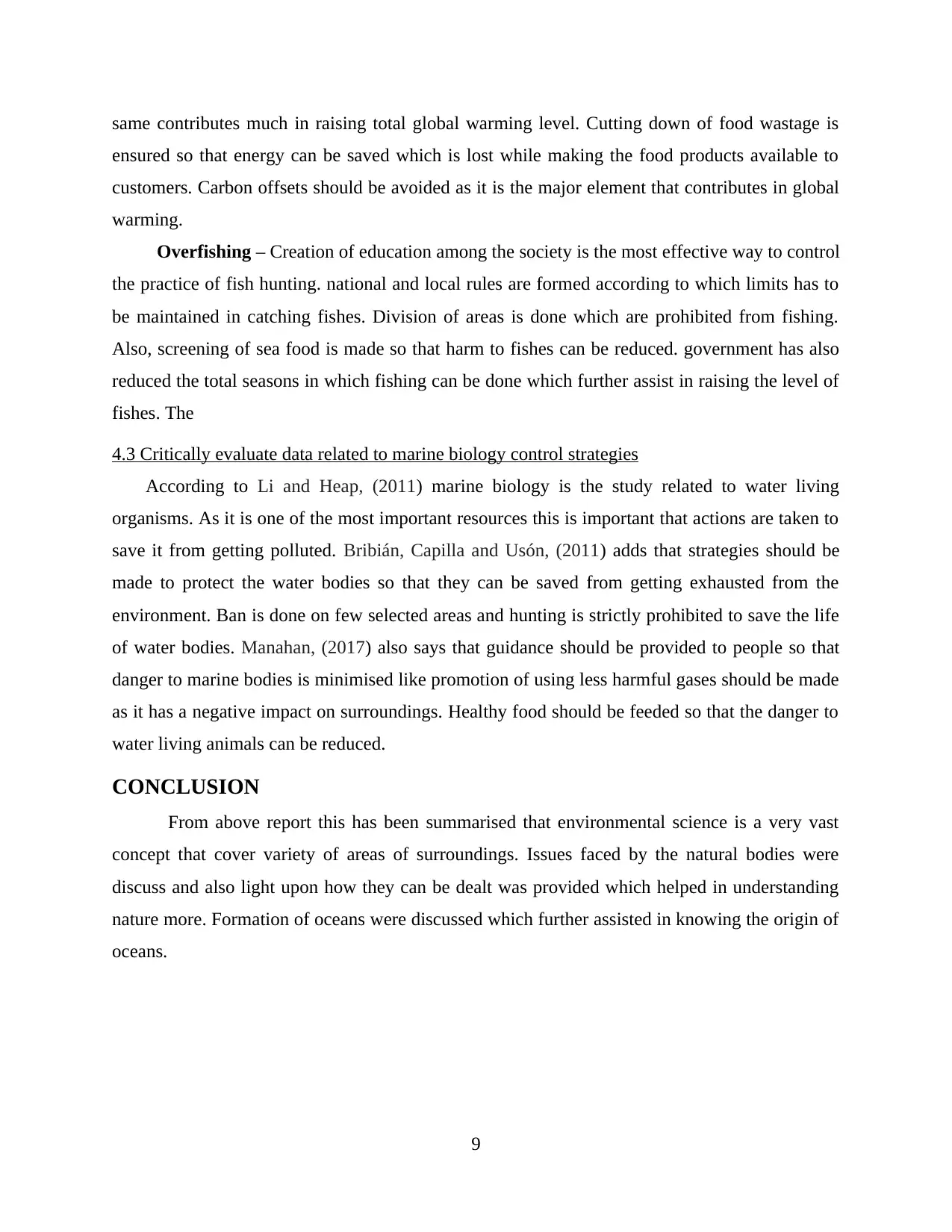
same contributes much in raising total global warming level. Cutting down of food wastage is
ensured so that energy can be saved which is lost while making the food products available to
customers. Carbon offsets should be avoided as it is the major element that contributes in global
warming.
Overfishing – Creation of education among the society is the most effective way to control
the practice of fish hunting. national and local rules are formed according to which limits has to
be maintained in catching fishes. Division of areas is done which are prohibited from fishing.
Also, screening of sea food is made so that harm to fishes can be reduced. government has also
reduced the total seasons in which fishing can be done which further assist in raising the level of
fishes. The
4.3 Critically evaluate data related to marine biology control strategies
According to Li and Heap, (2011) marine biology is the study related to water living
organisms. As it is one of the most important resources this is important that actions are taken to
save it from getting polluted. Bribián, Capilla and Usón, (2011) adds that strategies should be
made to protect the water bodies so that they can be saved from getting exhausted from the
environment. Ban is done on few selected areas and hunting is strictly prohibited to save the life
of water bodies. Manahan, (2017) also says that guidance should be provided to people so that
danger to marine bodies is minimised like promotion of using less harmful gases should be made
as it has a negative impact on surroundings. Healthy food should be feeded so that the danger to
water living animals can be reduced.
CONCLUSION
From above report this has been summarised that environmental science is a very vast
concept that cover variety of areas of surroundings. Issues faced by the natural bodies were
discuss and also light upon how they can be dealt was provided which helped in understanding
nature more. Formation of oceans were discussed which further assisted in knowing the origin of
oceans.
9
ensured so that energy can be saved which is lost while making the food products available to
customers. Carbon offsets should be avoided as it is the major element that contributes in global
warming.
Overfishing – Creation of education among the society is the most effective way to control
the practice of fish hunting. national and local rules are formed according to which limits has to
be maintained in catching fishes. Division of areas is done which are prohibited from fishing.
Also, screening of sea food is made so that harm to fishes can be reduced. government has also
reduced the total seasons in which fishing can be done which further assist in raising the level of
fishes. The
4.3 Critically evaluate data related to marine biology control strategies
According to Li and Heap, (2011) marine biology is the study related to water living
organisms. As it is one of the most important resources this is important that actions are taken to
save it from getting polluted. Bribián, Capilla and Usón, (2011) adds that strategies should be
made to protect the water bodies so that they can be saved from getting exhausted from the
environment. Ban is done on few selected areas and hunting is strictly prohibited to save the life
of water bodies. Manahan, (2017) also says that guidance should be provided to people so that
danger to marine bodies is minimised like promotion of using less harmful gases should be made
as it has a negative impact on surroundings. Healthy food should be feeded so that the danger to
water living animals can be reduced.
CONCLUSION
From above report this has been summarised that environmental science is a very vast
concept that cover variety of areas of surroundings. Issues faced by the natural bodies were
discuss and also light upon how they can be dealt was provided which helped in understanding
nature more. Formation of oceans were discussed which further assisted in knowing the origin of
oceans.
9
⊘ This is a preview!⊘
Do you want full access?
Subscribe today to unlock all pages.

Trusted by 1+ million students worldwide
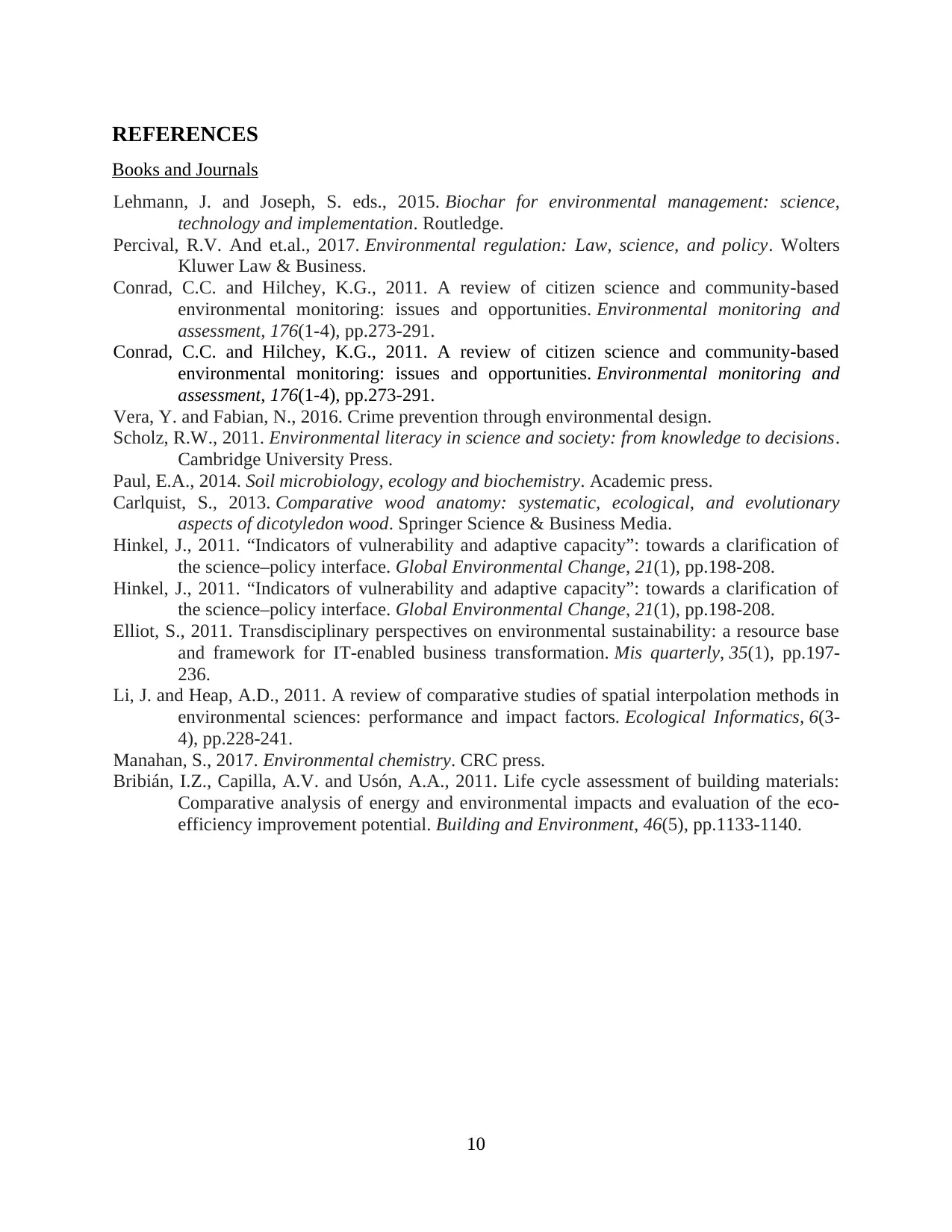
REFERENCES
Books and Journals
Lehmann, J. and Joseph, S. eds., 2015. Biochar for environmental management: science,
technology and implementation. Routledge.
Percival, R.V. And et.al., 2017. Environmental regulation: Law, science, and policy. Wolters
Kluwer Law & Business.
Conrad, C.C. and Hilchey, K.G., 2011. A review of citizen science and community-based
environmental monitoring: issues and opportunities. Environmental monitoring and
assessment, 176(1-4), pp.273-291.
Conrad, C.C. and Hilchey, K.G., 2011. A review of citizen science and community-based
environmental monitoring: issues and opportunities. Environmental monitoring and
assessment, 176(1-4), pp.273-291.
Vera, Y. and Fabian, N., 2016. Crime prevention through environmental design.
Scholz, R.W., 2011. Environmental literacy in science and society: from knowledge to decisions.
Cambridge University Press.
Paul, E.A., 2014. Soil microbiology, ecology and biochemistry. Academic press.
Carlquist, S., 2013. Comparative wood anatomy: systematic, ecological, and evolutionary
aspects of dicotyledon wood. Springer Science & Business Media.
Hinkel, J., 2011. “Indicators of vulnerability and adaptive capacity”: towards a clarification of
the science–policy interface. Global Environmental Change, 21(1), pp.198-208.
Hinkel, J., 2011. “Indicators of vulnerability and adaptive capacity”: towards a clarification of
the science–policy interface. Global Environmental Change, 21(1), pp.198-208.
Elliot, S., 2011. Transdisciplinary perspectives on environmental sustainability: a resource base
and framework for IT-enabled business transformation. Mis quarterly, 35(1), pp.197-
236.
Li, J. and Heap, A.D., 2011. A review of comparative studies of spatial interpolation methods in
environmental sciences: performance and impact factors. Ecological Informatics, 6(3-
4), pp.228-241.
Manahan, S., 2017. Environmental chemistry. CRC press.
Bribián, I.Z., Capilla, A.V. and Usón, A.A., 2011. Life cycle assessment of building materials:
Comparative analysis of energy and environmental impacts and evaluation of the eco-
efficiency improvement potential. Building and Environment, 46(5), pp.1133-1140.
10
Books and Journals
Lehmann, J. and Joseph, S. eds., 2015. Biochar for environmental management: science,
technology and implementation. Routledge.
Percival, R.V. And et.al., 2017. Environmental regulation: Law, science, and policy. Wolters
Kluwer Law & Business.
Conrad, C.C. and Hilchey, K.G., 2011. A review of citizen science and community-based
environmental monitoring: issues and opportunities. Environmental monitoring and
assessment, 176(1-4), pp.273-291.
Conrad, C.C. and Hilchey, K.G., 2011. A review of citizen science and community-based
environmental monitoring: issues and opportunities. Environmental monitoring and
assessment, 176(1-4), pp.273-291.
Vera, Y. and Fabian, N., 2016. Crime prevention through environmental design.
Scholz, R.W., 2011. Environmental literacy in science and society: from knowledge to decisions.
Cambridge University Press.
Paul, E.A., 2014. Soil microbiology, ecology and biochemistry. Academic press.
Carlquist, S., 2013. Comparative wood anatomy: systematic, ecological, and evolutionary
aspects of dicotyledon wood. Springer Science & Business Media.
Hinkel, J., 2011. “Indicators of vulnerability and adaptive capacity”: towards a clarification of
the science–policy interface. Global Environmental Change, 21(1), pp.198-208.
Hinkel, J., 2011. “Indicators of vulnerability and adaptive capacity”: towards a clarification of
the science–policy interface. Global Environmental Change, 21(1), pp.198-208.
Elliot, S., 2011. Transdisciplinary perspectives on environmental sustainability: a resource base
and framework for IT-enabled business transformation. Mis quarterly, 35(1), pp.197-
236.
Li, J. and Heap, A.D., 2011. A review of comparative studies of spatial interpolation methods in
environmental sciences: performance and impact factors. Ecological Informatics, 6(3-
4), pp.228-241.
Manahan, S., 2017. Environmental chemistry. CRC press.
Bribián, I.Z., Capilla, A.V. and Usón, A.A., 2011. Life cycle assessment of building materials:
Comparative analysis of energy and environmental impacts and evaluation of the eco-
efficiency improvement potential. Building and Environment, 46(5), pp.1133-1140.
10
1 out of 10
Related Documents
Your All-in-One AI-Powered Toolkit for Academic Success.
+13062052269
info@desklib.com
Available 24*7 on WhatsApp / Email
![[object Object]](/_next/static/media/star-bottom.7253800d.svg)
Unlock your academic potential
Copyright © 2020–2025 A2Z Services. All Rights Reserved. Developed and managed by ZUCOL.




